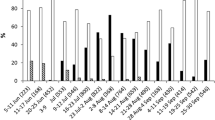Abstract
Schistocerca gregaria sometimes refuse to lay eggs into the “old sand” that is kept in their cages for several days. We investigated why they rejected the old sand for oviposition. Locusts exclusively laid eggs into new sand when presented together with old sand, indicating that the old sand contained an oviposition-inhibiting (OI) factor. We examined whether this factor was derived from locust feces or fed grass (Bromus catharticus). Locusts laid all eggs into the sand with grass when presented together with sand containing feces. In contrast, few eggs were laid into the sand with grass when clean sand was offered at the same time, suggesting that the OI factor originated from the grass and was concentrated in the feces. The OI factor was efficiently extracted from feces with water compared with ethanol and acetone. OI activity was detected by extraction of feces with water for 1 min, although a longer extraction time yielded higher activity. The water extract of feces retained OI activity after boiling. None of the eggs which were buried in sand containing fecal extract hatched, whereas most of the eggs buried in clean sand or sand containing grass extract hatched, showing a correlation between OI activity and a lethal effect on eggs.









Similar content being viewed by others
References
Bashir MO, Hassanali A, Rai MM, Saini RK (2000) Changing oviposition preferences of the desert locust, Schistocerca gregaria, suggest a strong species predisposition for gregarization. J Chem Ecol 26:1721–1733
Ji R, Xie B-Y, Li D-M, Li Z, Zeng X-C (2007) Relationships between spatial pattern of Locusta migratoria manilensis eggpods and soil property variability in coastal areas. Soil Biol Biochem 39:1865–1869
Newland PL, Yates P (2008) The role of contact chemoreception in egg-laying behaviour of locusts. J Insect Physiol 54:273–285
Norris MJ (1968) Laboratory experiments on oviposition responses of the desert locust, Schistocerca gregaria (Forsk). Anti Locust Bull 43:1–47
Pener MP (1991) Locust phase polymorphism and its endocrine relations. Adv Insect Physiol 23:1–79
Pener MP, Simpson SJ (2009) Locust phase polyphenism: an update. Adv Insect Physiol 36:1–272
Pinto-Escobar P (1985) Nota sobre Bromus willdenowii Kunth. Caldasia 14:185–191
Sugahara R, Tanaka S, Jouraku A, Shiotsuki T (2016) Functional characterization of the corazonin-encoding gene in phase polyphenism of the migratory locust, Locusta migratoria (Orthoptera: Acrididae). Appl Entomol Zool 51:225–232
Sugahara R, Tanaka S, Jouraku A, Shiotsuki T (2017) Geographic variation in RNAi sensitivity in the migratory locust. Gene 605:5–11
Tanaka S (2006) Corazonin and locust phase polyphenism. Appl Entomol Zool 41:179–193
Tanaka S, Harano K, Nishide Y (2012) Re-examination of the roles of environmental factors in the control of body-color polyphenism in solitarious nymphs of the desert locust Schistocerca gregaria with special reference to substrate color and humidity. J Insect Physiol 58:89–101
Tanaka S, Harano K, Nishide Y, Sugahara R (2016) The mechanism controlling phenotypic plasticity of body color in the desert locust: some recent progress. Curr Opin Insect Sci 17:10–15
Uvarov BP (1928) Locusts and grasshoppers: a handbook for their study and control. The Imperial Bureau of Entomology, London
Uvarov B (1966) Grasshoppers and Locusts: a handbook of general acridology. Anatomy, physiology, development, phase polymorphism, introduction to taxonomy, vol 1. Cambridge University Press, Cambridge
Uvarov B (1977) Grasshoppers and locusts: a handbook of general acridology. Behaviour, ecology, biogeography, population dynamics, vol 2. Cambridge Centre for Overseas Pest Research
van Huis A, Woldewahid G, Toleubayev K, van der Werf W (2008) Relationships between food quality and fitness in the desert locust, Schistocerca gregaria, and its distribution over habitats on the Red Sea coastal plain of Sudan. Entomol Exp Appl 127:144–156
Verloove F (2012) A revision of Bromus section Ceratochloa (Pooideae, Poaceae) in Belgium. Dumortiera 101:30–45
Wang X, Kang L (2014) Molecular mechanisms of phase change in locusts. Annu Rev Entomol 59:225–244
Woodman JD (2017) Effects of substrate salinity on oviposition, embryonic development and survival in the Australian plague locust, Chortoicetes terminifera (Walker). J Insect Physiol 96:9–13
Woodrow DF (1965a) The responses of the African migratory locust, Locusta migratoria migratorioides R. & F. to the chemical composition of the soil at oviposition. Anim Behav 13:348–356
Woodrow DF (1965b) Laboratory analysis of oviposition behaviour in the red locust, Nomadacris septemfasciata (Serv). Bull Entomol Res 55:733–745
Acknowledgments
We thank Ms. Utako Takano, Ms. Hiroko Ikeda, Ms. Masako Higuchi, and Ms. Harumi Murata for assistance with rearing locusts. Thanks are also due to Dr. Takahiro Shiotsuki and Dr. Toyomi Kotaki for logistics support, and to Dr. Hiroe Yasui for technical advice and help with freeze-drying fecal samples. Prof. Sadao Wakamura (Kyoto Gakuen University) gave us valuable technical suggestions and read an early version of the manuscript. R. S. was supported by a Japan Society for the Promotion of Science (JSPS) Kakenhi Grant (no. 15J08228) and JSPS Research Fellowships for Young Scientists. We would like to thank Mr. Kameo Tsukada and Mr. Hirokazu Tomiyama (Field Management Section of NAFO) for growing the grass. This work is dedicated to the late Professor Emeritus Sinzo Masaki (Hirosaki University) who suggested S. T. study locusts and gave him much encouragement for many years; he passed away at the age 89 on 28 January 2017.
Author information
Authors and Affiliations
Corresponding author
Rights and permissions
About this article
Cite this article
Tanaka, S., Sugahara, R. Desert locusts Schistocerca gregaria (Acrididae: Orthoptera) do not lay eggs in old sand: Why?. Appl Entomol Zool 52, 635–642 (2017). https://doi.org/10.1007/s13355-017-0518-8
Received:
Accepted:
Published:
Issue Date:
DOI: https://doi.org/10.1007/s13355-017-0518-8




